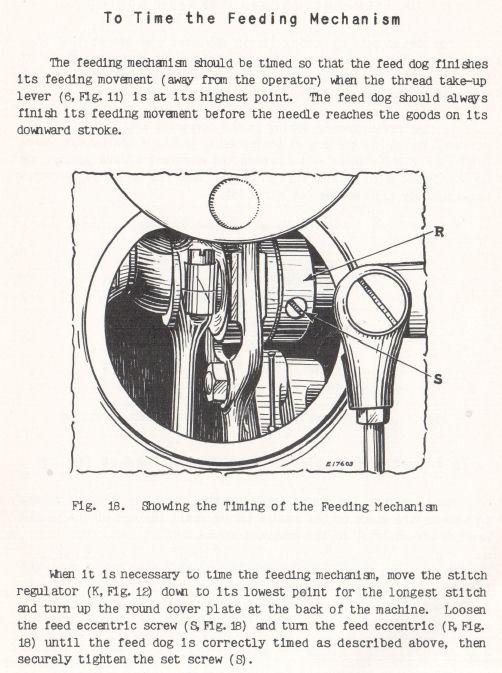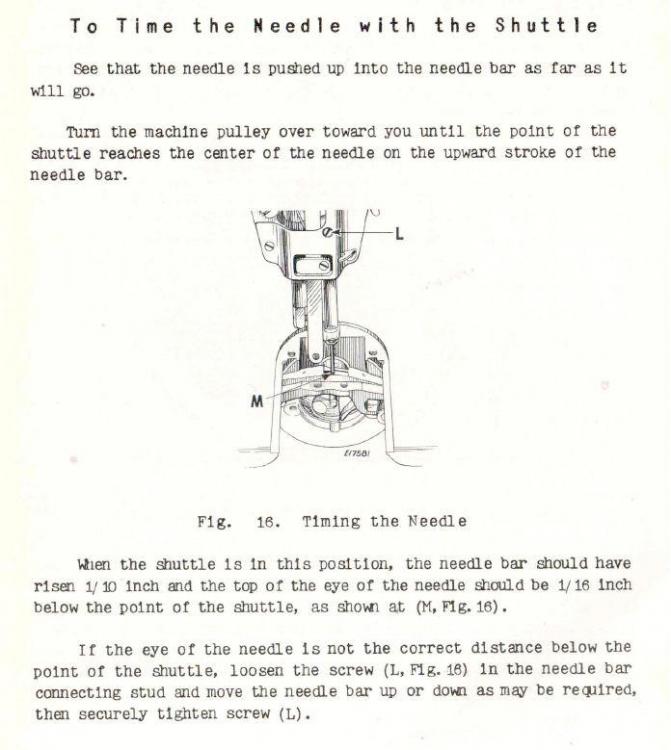-
Posts
5,711 -
Joined
-
Last visited
Content Type
Profiles
Forums
Events
Blogs
Gallery
Everything posted by Constabulary
-
What in particular are Deutsch Hooks? Do you have a picture?
-

What can you tell me about this machine?
Constabulary replied to mek1941's topic in Leather Sewing Machines
Chart in the manual says up to #26 needle. But I seriously doubt that #26 needle where available for this needle system because of the thin shaft (below 2mm). And I doubt the thick thread would pass the gap between hook and needle plate w/o problems because the machine (at least mine) has no bobbin case opener. Later machines have a bobbin case opener (see manual I sent you). Realistic is a #22 needle and 138 thread max. I´d say. But I usually run #92 / #96 thread in this machine. The availability of system 128 needles on my side of the pond and the condition of the original needle bar lead me to the idea of changing the needle bar. So now I´m able to use "common needles". But that required modifying the machine. I had to install a longer needle bar guide on the upper end because the "new" needle bar was a lot shorter than the original needle bar. The majority of my machines are using 135x17 needles and therefore the decision was easy to set up this machine for 135x17 as well so I do not have to stock lots of different needle systems. EDIT: I have to correct my self. I just have checked an old needle catalogue and it states #26 where available for system 128 (decades ago...). Does not make much sense IMO but well, thats what the catalogue says. I stick to my opinion that 138 and #22 needle at max. is a reasonable combination. But he limitation is pretty much the size of the needle hole in your needle plate. -

What can you tell me about this machine?
Constabulary replied to mek1941's topic in Leather Sewing Machines
I have a manual for an early 51w meanwhile (came from a LW member) but it is not exactly for your (our) machine(s) subclass but anyway it is a usable manual but has some technical differences. File is too big to attach here. Please send me your email address by PM if you are interested. I own the 51WSV2 UWE has liked to. Very decent machine. Of course not the latest technical craze but hey forming a thread knot has not changed the "last years" so mine really works very well, I´m pleased. However I made several technical changes like different hook and different needle bar to accommodate a more common needle (137x17) and so forth. I also found new made feed dogs and needle plates that fits this decades old machine. I also increased the stitch length but I explained all that in the above linked thread. This parts list should be quite close for your machine: Download Link: Singer 51w25 to 31 Parts list -
DBx1 and 1738 are the same needle. So when a lot of needles are braking there seems to be a technical problem. Leather point needle in this system are : 16X257LR / DBXF2 / 1738LR What means "top is too narrow"?
-
Do you have pictures of that machine? Not all Class 67 where triple feed ("walking foot") machines they came as needle feed + drop feed and roller foot machines as well. So before you make the trip some pictures may help to ID the machine.
-
Most important - check the condition of the timing belt - changing it is a pain!
-
If it was my machine I`d order some "common" needle systems for testing (like 328, 794, 1000) in approx size 180 or 200 and test them in different needle holder positions. This of course is trial and error and no one knows if any of the needles will work. Another option is you look for some rigid / stiff 2mm - 3mm round bar / round material (depends on how wide the needle hole is) for inserting it as a needle substitute. Make sure it is not hitting parts somewhere. Shove it all the way up into the needle holder. Then rotate the hand wheel until the tip of the shuttle meets the needle substitute in the middle of the "needle" and make a mark with an Edding or similar where the shuttle tip meets the needle. Test this in all needle holder positions. Measure the distance from top of the "needle" down to the edding mark and with this measure we can "try" to find a needle that "could" probably work. This of course is not a very precise method but you do not have many options since you do not have an original neelde. Threading the shuttle should be fairly easy to figure and for the top thread path I guess I have a manual of an older Adler II flat bed machine that should work for your machine as well. BTW - just wondering is the shuttle carrier rotating or oscillating. Also if you don´t mind please post some more pictures of the machine in full view form all sides and some detailed pictures of the external parts. Can´t be wrong to have some documentation for the future. Does your machine have a bobbin winder?
-

Singer 16-41 hook and needle timing help.
Constabulary replied to Restorer's topic in Leather Sewing Machines
You are welcome, Jack -
So when I look closer at your needle holder it appears that it is height adjustable and probably could take shorter needles / more common needles as well. Can you take a picture of the opposite side of the needle bar please? In best case you may be able to reposition or maybe modify the holder to accommodate common (modern) needles like the 794 or others.
-
Well question like this have been covered probbaly a dozen times. Thats quite a wide range of material thickness from 2x 2 ounce (together approx 1mm) to 6x 4 ounce (together approx 15mm) So you either end up with (at least) 2 machines or you rethink your material thicknesses. You really want to sew 15mm (take a ruler and check) or is it rather less? It´s less, right? Layers do not matter really, the total material thickness matters. New or refurbished doesn't matter in the end. You can have new machines which are poorly set up / do not suit your needs or you can have a refurbished machine which is set up perfectly for what you want to do. That often depends on your dealer or the seller. Can´t be wrong if you check with dealer who is specialized in leather sewing machines. Machines often look the same but can be set up for different purposes. If you buy used from a private seller always test the machine with the max. thread and material thickness you want to sew. But keep in mind the motor matters a lot. It´s not only the machine that has to suit your needs, the motor is very important too. So it can happen that your machine is great but the motor sucks (too fast, not powerful enough...). Since you like UWE´s FBA - have you checked with him if he could offer you a proper machine? Just an idea...
-
Good Lord A post bed machine made by KOCH (later Koch´s Adler, then Adler, nowadays Dürkopp-Adler) but I do not know the model. I only can guess - I assume it is a "KOCHS ADLER - Sattler Universal Class 23. If that is the case (I only can guess) then the needle system is 580 / 585A. System 580 is a ~ 10,5cm long needle but it is obsolete. As Jimi said, pictures are too small to tell details. Most likely the flat bed version of this machine were either the Adler II or Adler III. H. Sackmann appears to be the dealer the machine once was bought from. Do you have the shuttle hook (see pictures 3,4) and maybe a bobbin? Open the cover plate on the post and hopefully the parts are present. If present please post some pictures. If the the parts are missing (or maybe they are in the drawer?) there is almost no chance to find the parts, I´d say. This is what I have cobbled together from my records (see pictures)
-

Need help on value of a Pearson No 6 bobbin winder
Constabulary replied to mogwild's topic in Leather Sewing Machines
I read prices of up to $600 but that could have been Aussie Dollars. Right now one is on ebay for 499 GBP but yours appears to be in better condition (but I would clean it anyway) but I don´t think the one on Ebay will sell for that price. https://www.ebay.co.uk/itm/Original-Bobbin-Winder-For-Pearson-6-Harness-British-United-Leather-Stitcher-/264340833603 If you want to sell it fast I think a fair price is $300-350 -

Singer 16-41 hook and needle timing help.
Constabulary replied to Restorer's topic in Leather Sewing Machines
so it was the motor and not the machine, right? For the thread hole try abrasive / emery cord. -
Not exactly sure what you mean? You mean technical data and capabilities? If not a 29K1 then your machine is a US made machine otherwise it is made in the UK.The machine is approx a century old (or older) - you can tell by the serial number. Very few parts are available new (some remained the same up to the latest model) , needle plates and gear box pinions are no longer available new (you may find some used in best case), the needle plates and pinions you find online are usually for the latest model and do not fit the 29-1. The Bell crank lever of the latest 29K models can be modified to fit the old 29 / 29K models. Hooks and bobbins remained the same as well as the parts of the thread tension units. Machine should be able to handle #138 thread max. but may depend on the needle plate hole and the hook. So #96 most-likely will work better. Max stitch length in best case is 5 SPI / 5mm but on used / old machines rather expect 2.5 - 3mm (because of parts wear) but you never know - depends on the conditions of the machine. And the thicker the material the shorter become the stitches. Machine should be able to handle 6-8mm stick materials. So thats what comes to my mind... hope it helps. A few years ago I have restored a 29K1. This was mine - maybe you find some useful information in this thread:
-

Singer 16-41 hook and needle timing help.
Constabulary replied to Restorer's topic in Leather Sewing Machines
This may be of interest for you. You machine is not listed but anyway.... https://www.sil.si.edu/DigitalCollections/Trade-Literature/Sewing-Machines/NMAHTEX/2753/imagepages/image35.htm I found an "odd" Singer 16KSV11 approx 1.5 years ago and reworked it. This ways mine (sold it). Regarding clockwise rotation - well you live in down under **kidding** I think you can reverse the feed direction by adjusting the feed cam on the top shaft. I once did that on a friends Dürkopp machine but not on a class 16 but I guess its similar. Here again is an extract from a Class 31 manual I think its the same as on the Class 16. But be careful with this you may have a binding at one point. I´d put a mark on the feed cam and the shaft before making adjustments so you always can go back to the original setting. Hope it helps. -

Singer 16-41 hook and needle timing help.
Constabulary replied to Restorer's topic in Leather Sewing Machines
I have no timing values for the Class 16 but afaik it has a CB hook. And on most (if not all) CB hook machines you usually you bring the needle bar to bottom dead center and from there you rise the needle bar approx 2.5mm (as I said I have no exact values for the Class 16) and an that point the hook tip should be in the center of the needle approx 2mm above the needle eye. Have to check if I can find a manual or so.... EDIT: this is an extract from a Singer 31-19 manual but should work for CB hooks Class 16 machines as well -
Yeah - thats on me - it was meant to be a just a link in the signature but forum turned it into a full size video. I removed it I also have hidden some over sized signatures of members.
-

Sewing machine category AL BL Pfaff 471
Constabulary replied to slepsnys's topic in Leather Sewing Machines
Best bet - go and test either machine to see if it suit your needs. The data plate shows the technical state / set up the machine left the factory with. But it could well be that the machines have been modified or reworked (not unusual) and are no longer set up the way they left the factory. -

Taking TK-8BL Sewing Machine
Constabulary replied to RhodesAveDesigns's topic in Leather Sewing Machines
looks like a Juki 563 (large hook) or 562 (standard hook) to me -
1st I´d check with LW member SHOEPATCHER
-

Edge Binding using flatbed folder on cylinder bed
Constabulary replied to kgg's topic in Clothing, Jackets, Vests and Chaps
THANK YOU for your pictures. I honestly did not know how I could achieve this clean end when binding (the in folded tape I mean). Usually my "binding tape end" is folded over by 1/2" or so and bar tacked and I rarely need this "fold in end" but now that I see it it its obvious but I honestly had no idea. Tried it and it works with my cheap binders and thick cotton tape . Ha Ha - again - Thank you. -

Important Customs news for UK/Eu leatherworkers
Constabulary replied to fredk's topic in Marketing and Advertising
so we can´t blame you , well maybe a little bit Have you tried a "parcel forwarder" who is collecting and consolidating your packages and send them to you combined in one package? Know what I mean? Like this one but there are many more: https://www.forward2me.com/ Not sure if this is an option for you but maybe worth checking. -
expect to pay serious $$$ for the missing parts. Looks like your needle plate is missing too. I´m not sure if Seiko SLH-2 parts will work but if so the shuttle race would be approx 300 or more + 200 or more for the hook I guess.




